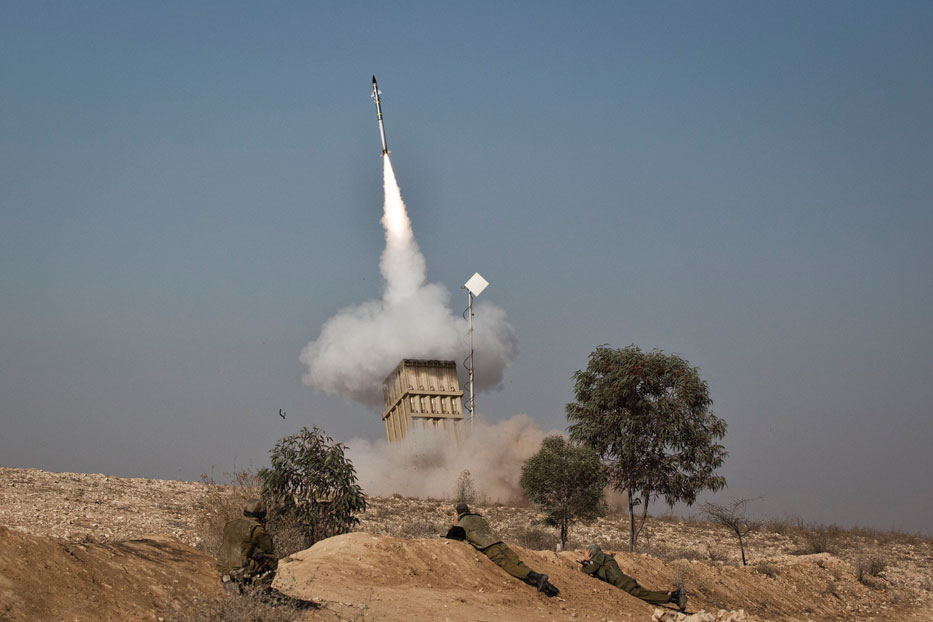 An Iron Dome anti-missile station (Photo by Ilia Yefimovich/Getty Images)
An Iron Dome anti-missile station (Photo by Ilia Yefimovich/Getty Images) Iran broke the seal on its conflict with Israel last week. Instead of using one of its many terror proxies to attack Israel, it went solo, mano a mano, by launching a probing, unmanned drone into Israel that the Israel Defense Forces were forced to take down. An Israeli jet was destroyed in the skirmishes that followed. This is an ominous escalation of a growing, tense conflict between Israel and Iran.
With Iran so embedded on Israel’s border, Israelis must prepare to defend against not only medium-range missiles fired from mountain bunkers in Syria, but also the potential threat that Tehran might directly join the assault on the Jewish state with its own longer-range arsenal.
So, while American defense planners concentrate on rising tensions with “the loco in NoKo,” the IDF has its hands full as Iranian allies Syria and Russia provide air defenses against prospective Israeli air force strikes on deeply buried underground sites launching missiles into Tel Aviv.
The answer to that challenge is the ever improving success of missile defense.
President Ronald Reagan launched the Strategic Defense Initiative 35 years ago, challenging the immorality of the policy of “mutually assured destruction” (MAD) of any nation whose government launched a first-strike nuclear attack against the United States or our treaty allies. The MAD doctrine threatened millions of civilians under tyranny, likely deterring U.S. counter-strikes, not the Soviet “Evil Empire.”
Instead, Reagan proposed a more prudential course to deter war and to increase our national security capability, via an integrated and layered architecture of networked sensors and ground- and sea-based detection radars and interceptor missiles seeking “hit to kill,” or explosive blast fragmentation, of enemy warheads.
Liberal critics mocked Reagan’s vision as “Star Wars,” proclaiming “a bullet cannot hit a bullet.” They were wrong. And they continue to fret that missile defense is “flawed, imperfect and expensive.”
But decades of startling scientific and technological advancements have resulted in ballistic missile defense elements now operated by United States military personnel at U.S. Strategic, Northern, Pacific and European commands and U.S. Forces Japan.
Detractors rarely note that Israelis sleep under the proven protection of the Iron Dome.
Missile defense doesn’t promise perfection. But detractors rarely note that Israelis sleep under the proven protection of the Iron Dome, and the steadily developing David’s Sling and Arrow missile defense systems funded, developed and tested in cooperative ventures with the United States.
U.S. and Israeli intelligence communities track rocket and missile threats proliferating from a dangerous array of national and nonstate terror actors projecting power in regional and strategic contexts and featuring potential new countermeasures such as hypersonic glide vehicles and varying trajectories to make short, medium, intermediate and intercontinental range missile threats more complex, survivable, reliable and accurate.
Defense analysts consider Iranian and North Korean missile accuracy, range and lethality of particular concern.
Iran threatens maritime activity throughout the Persian Gulf and Strait of Hormuz and has famously inscribed the slogan “Death to Israel” on missiles featured at military parades. Iran’s progress on space launch vehicles provides Tehran with the means and motivation to improve their submunition payloads as they continue to develop intercontinental ballistic missiles (ICBMs).
North Korea has expanded the sophistication and range of its ballistic missile forces with an unprecedented level of nuclear tests and ballistic missile launches. When a state employee in Hawaii accidentally created a false alarm, citizens and tourists experienced the existential threats humanity faces from rogue regimes such as North Korea, which might blackmail the West with threats to shut down the American electrical grid with an EMP attack over the U.S. continental homeland.
In the age of missiles, robust, operational and position-optimized missile defense systems are mandatory for the U.S. and Israel to deter and defend against any potentially imprudent, irrational or ideological adversary.
Larry Greenfield is a fellow of the Claremont Institute for the Study of Statesmanship & Political Philosophy.





















 More news and opinions than at a Shabbat dinner, right in your inbox.
More news and opinions than at a Shabbat dinner, right in your inbox.